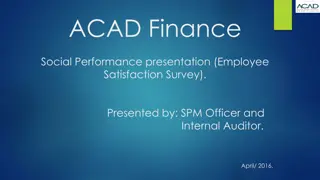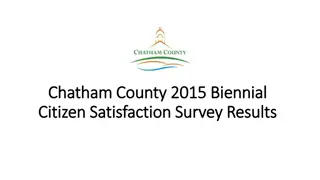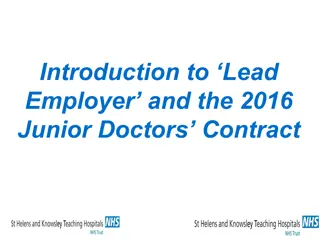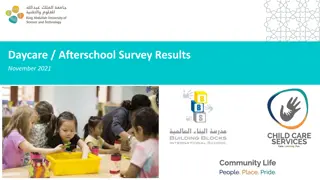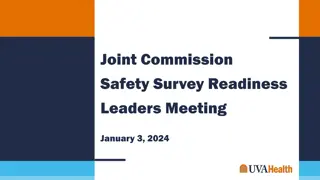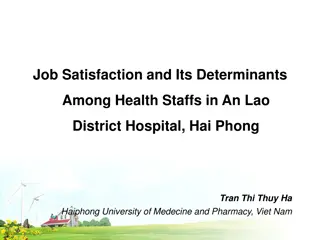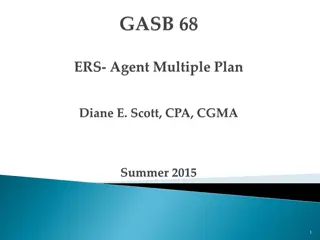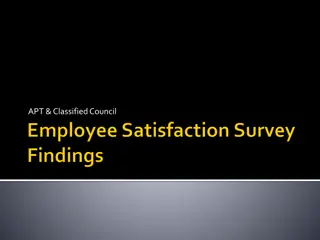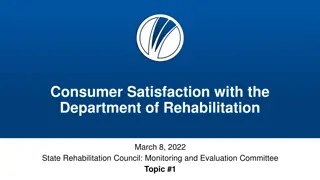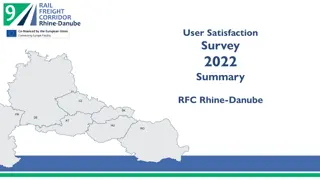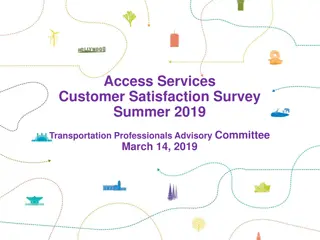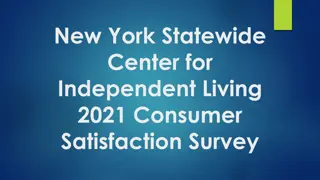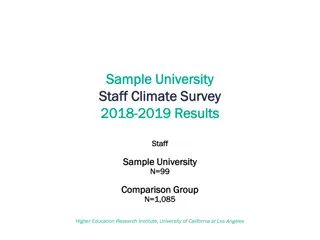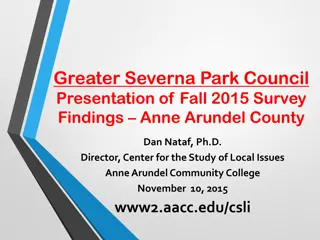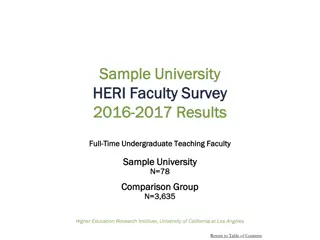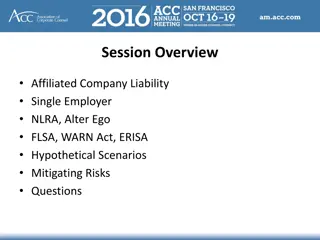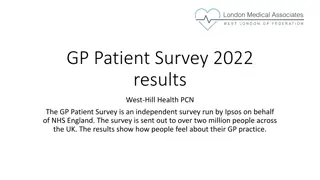Employer Satisfaction Survey 2015-2016: Key Findings and Analysis
This report presents key findings from the Employer Satisfaction Survey 2015-2016, which gathered feedback from over 60,000 employers who received training funded by the Skills Funding Agency. The survey reflects positive employer satisfaction levels with the training providers, particularly in the areas of overall quality and advocacy. Employers predominantly utilized providers for delivering apprenticeship training, with a focus on Business, Administration, and Law apprenticeships. The report outlines employer profiles, reasons for choices, course details, overall ratings, and detailed analysis based on the survey results.
Download Presentation

Please find below an Image/Link to download the presentation.
The content on the website is provided AS IS for your information and personal use only. It may not be sold, licensed, or shared on other websites without obtaining consent from the author. Download presentation by click this link. If you encounter any issues during the download, it is possible that the publisher has removed the file from their server.
E N D
Presentation Transcript
Employer Satisfaction Survey 2015 to 2016 National Results December 2016
Contents 01 Introduction..................................2 02 Executive summary ....................4 03 Employer profile..........................6 04 Reasons for choice ..11 05 Course details . 14 06 Overall rating.............................18 07 Detailed analysis.......................23 1
Introduction This report presents key findings from the Employer Satisfaction Survey 2015 to 2016. Over 60,000 employers took part in this survey, making it one of the largest survey of its kind. The survey gives employers the opportunity to comment on the training their employees received. The employers that took part in the survey had received funding from the Skills Funding Agency to deliver apprenticeship and work-based learning to their employees between August 2015 and February 2016. During this period, a total of 268,575 employers received training funded by the Skills Funding Agency. The training was delivered by 689 providers including General Further Education (FE) Colleges, independent learning providers, other public-funded organisations, and Special and Specialist Colleges. The survey took place between March and July 2016; 75% of employers completed the survey online, 16% used paper questionnaires and 8% responded by telephone. 3
Executive summary Employers remain overwhelming positive about their provider: 78% were satisfied with the overall quality and 80% would be advocates of the training provider. More employers are satisfied on both these measures compared to the 2014 to 2015 survey. The vast majority, 99%, of workplaces that took part in the survey, were using providers to deliver apprenticeship training. More were delivering apprenticeships for adults than young people aged 16-18, with those only delivering training to young people the least positive about it. Apprenticeships in Business, Administration and Law continue to dominate. Slightly more employers in this year s survey were delivering this framework compared to the 2014 to 2015 survey (30% compared to 29%). Engineering and Manufacturing Technologies (22%) remains the subject with the second highest apprenticeship employer volume, followed by Health, Public Services and Care (21%). 5
Employer profile Employer respondents are broadly representative of the 268,575 employers who received training in terms of workplace size (below) and industry sector (slide 8). The majority, 77%, worked in small workplaces with 1-49 employees; 16% in workplaces with 50-249 employees; and 7% in the largest workplaces (250+ employees). Over half of workplaces, 57%, were single site organisations, 27% were branches of an organisation, and a further 14% were head offices. All workplaces receiving funding* Survey respondents** Number of workplaces Number of responses Size of workplace % of total % of total 1 1,834 3.0 18,492 6.9 2-9 20,472 33.9 85,415 31.8 10-49 23,991 39.7 114,276 42.6 50-249 9,761 16.1 36,368 13.5 250+ 4,063 6.7 12,217 4.6 327 0.5 Don t know/missing 1,807 0.7 Total 60,448 100% 268,575 100% 7 FE Choices Employer Satisfaction Survey 2015 to 2016. Total base size: 60,448. Base size varies for individual questions due to non-response. *Based on sample information. ** Based on survey responses which may be different to the information held on the sample.
Employer profile The largest group of employer respondents were in the human health and social work activities sector, followed by wholesale and retail trade . This pattern was also observed in the 2014 to 2015 survey. All workplaces receiving funding* Survey respondents** Industry Sector of the workplace Number of workplaces % of total Responses % of total Agriculture, forestry, and fishing 3,340 1.2 991 1.6 Mining, quarrying, manufacturing, electricity, gas and water supply 21,000 7.5 5,860 9.7 Construction 34,019 12.7 6,435 10.6 Wholesale and retail trade: repair of motor vehicles and motorcycles 35,283 13.1 8,153 13.5 Accommodation and food service activities 17,335 6.5 2,271 3.8 Transport, storage, information and communications 10,051 3.8 2,349 3.9 Financial and insurance activities 4,153 1.6 845 1.4 Real estate, professional/scientific/technical, administrative/support service activities 24,983 9.3 6,106 10.1 Public administration and defence; compulsory social security 4,778 1.8 1,094 1.8 Education 19,255 7.2 4,588 7.6 Human health and social work activities 52,443 19.5 11,536 19.1 Arts/entertainment/recreation and other service activities 26,884 10.0 6,916 11.4 Other Total 15,051 268,575 5.6 3,304 60,448 5.5 100% 8 100%
Employer profile Over three-quarters (78%) of employers who took part in the survey reported they had between 1-4 learners. One in ten had 5-9 learners and a similar proportion had 10+ learners. Overall, workplaces that are part of a larger organisation had more learners. Employers in Health, Public Services and Care andLeisure, Travel and Tourism were more likely than average to report having 5 or more learners. Number of employees receiving training Number of employer responses 25,952 % of total 43% 1 20,764 35% 2-4 5,994 10% 5-9 2,947 5% 10-19 940 2% 20-29 1,460 2% 30 or more 1,989 3% Don t know/missing Total 60,046 100% FE Choices Employer Satisfaction Survey 2015 to 2016. Total base size: 60,046. Base size varies for individual questions due to non-response. 9
Employer profile Almost a quarter of employers, 24%, reported that they had made a financial contribution to the cost of the training. This is consistent with the level reported in last year s survey. Medium (50-249 employees) and large (250+ employees) workplaces were more likely than small workplaces to have contributed to the cost of the training: 31% and 45% respectively, compared with 21% of small workplaces with 1-49 employees. Fewer large and small workplaces reported making a financial contribution compared to the previous year s survey (47% and 22% respectively in the 2014 to 2015 survey). Whether paid for training Number % of total 6,612 11% Yes, in all cases Yes, in some cases No 7,834 13% 40,749 69% 4,061 7% Don t know Total 59,256 100% FE Choices Employer Satisfaction Survey 2015 to 2016. Total base size: 59,256. Base size varies for individual questions due to non-response. 10
Reasons for choosing provider and course 11
Reasons for choice The main reasons given by employers for choosing the provider is because they provide the relevant courses, to a high quality standard, and are local to them (slide 13). Employers in the agriculture sector were most likely have chosen the provider because they offer the relevant courses, whilst those in public administration and defence; compulsory social security and other service activities were more likely to have chosen the provider for the quality of their training. The main reason given by employers for offering the training course is because they were approached by a training provider. A quarter said they routinely take on apprentices and 15% were asked to by their employee. 12
Reasons for choice Q6 Why did you choose to use this training provider? Q7 What prompted you to start offering this training? What prompted you to start offering this training? Why did you choose to use this training provider? Approached by a training provider 61% They provide relevant courses 30% 34% 41% Routinely taken on apprentices They are local to us 24% 15% The quality or standard of the courses or training provided is high 38% An employee enquired about it 21% 15% 24% We have always used them National Apprenticeship Service 9% 10% 18% They approached us with a good offer 6% Another part of the organisation 9% They tailor courses to meet our specific needs 18% 5% Saw publicity/advertising 7% 14% Good value for money 2% Find an Apprentice' online service 2% 11% Other 8% Other 14% 3% Don't know 1% Don't know 5% All reasons Main reason FE Choices Employer Satisfaction Survey 2015 to 2016. Total base size: 53,072 (Q6) and 60,097 (Q7). 13
Course details The vast majority (99%) of employers that took part in the survey delivered apprenticeship training. Four per cent delivered workplace learning. Over half of employers, 55%, used an independent training provider and 41% used a General FE College. A very small minority of employers used other public-funded organisations (2%) and Special and Specialist Colleges (2%). Adult apprenticeships were more common than apprenticeships for 16-18 year olds (65% and 52% respectively). Linked to this, Level 2 apprenticeships were more commonly delivered by employers than Level 3. This pattern is similar to the 2014 to 2015 survey. Level 2 qualifications were also most commonly offered by employers delivering workplace learning. 15
Course details Employers were involved in delivering training across a diverse range of Sector Subject Areas (SSAs) see slide 17. There have been some changes compared to the 2014 to 2015 survey. The most common SSA reported by employers delivering apprenticeships was Business, Administration and Law. This SSA was most commonly reported in last year s survey too although there has been a slight increase this year: 30% said they had employees undertaking this SSA compared to 29% in the previous year. Engineering and Manufacturing Technologies has overtaken Health, Public Services and Care for the second year running as the second most common SSA reported by employers delivering apprenticeships (22% and 21% respectively). Among the small minority of employers delivering workplace learning, the most common SSA was Health, Public Services and Care (1% of employers were delivering this). 16
Course details Apprenticeship Work Place Learning Sector Subject Area Number of employers % Number of employers % employers employers 1 Health, Public Services and Care 2 Science and Mathematics 3 Agriculture, Horticulture and Animal Care 4 Engineering and Manufacturing Technologies 5 Construction, Planning and the Built Environment 6 Information and Communication Technology 7 Retail and Commercial Enterprise 8 Leisure, Travel and Tourism 9 Arts, Media and Publishing 12 Languages, literature and culture 13 Education and Training 14 Preparation for Life and Work 15 Business, Administration and Law 12,544 117 2,576 13,705 20.5 0.2 4.2 22.4 681 1.1 0 * 0 43 280 0.5 3,244 5.3 414 0.7 1,982 9,679 914 312 3.2 15.8 1.5 0.5 15 0 176 23 10 0.3 0 0 * 0 0 0 2 1,166 1.9 58 0 0 300 164 0.5 0.3 18,544 30.3 Note: the total sum to more than 100% because employers can be delivering multiple subjects. FE Choices Employer Satisfaction Survey 2015 to 2016. Total base size: 61,224. 17
Overall rating Employers satisfaction with the overall quality of training has increased compared to last year, 78% gave a rating of 8-10 compared with 73% in the previous year. Furthermore, more employers reported that they would recommend the training to another employer seeking similar training, an increase from 77% to 80% this year. Overall, 78% of employers expressed satisfaction with their training provider (Q4a,b, Q5). Employers were less positive about their ability to influence the structure of training (Q4c),with 69% giving a positive rating of 8-10 and 15% giving it a rating of 0-5. This question was included for the first time this year. Independent training providers consistently received more positive ratings than other providers. Ratings for General FE colleges, other public-funded organisations, and Special and Specialist Colleges were slightly lower (though still very positive). This pattern was also observed in previous years surveys. 19
Overall rating Please rate each of the following... (0=low score, 10=high score) Provider type (% score 8-10) 0-4 5 6-7 8-10 Other Public Private Sector Special Colleges General FE MEAN How satisfied or dissatisfied were you with the training provider overall 4% 6% 13% 78% 74 77 81 67 8.35 How satisfied or dissatisfied were you with the overall 4% 75 77 82 68 8.39 5% 13% 78% quality of the training/assessment How satisfied or dissatisfied were you with your ability to influence the structure, content, delivery and duration 6% 65 63 74 53 7.92 9% 16% 69% of the training How likely would you be to recommend this training provider to another employer seeking similar training 3% 77 78 83 71 8.49 6% 10% 80% FE Choices Employer Satisfaction Survey 2015 to 2016. Total base size: 60,448 (see slides 28 to 41 for base size for individual questions) 20
Key aspects Employers were also positive on key aspects of the training, with the majority (more than seven in ten) giving a rating of 8-10. Ratings across all measures have improved since the 2014 to 2015 survey. Employers remained especially positive about the professionalism of the staff delivering the training (82% gave a rating of 8-10), the use of up-to-date industry practices (79%) , and the flexibility of the training (78%). Rating for staff professionalism and flexibility of training have both increased by four percentage points since the 2014 to 2015 survey, mainly among users of other public- funded organisations and special colleges. Employers continue to be least positive about providers clarity of communication and the efficiency of their dealings with them (12% and 11% respectively gave a rating of 0-5 out of 10). 21
Key aspects Please rate each of the following... (0=low score, 10=high score) Provider type (% score 8-10) 0-4 5 6-7 8-10 Other Public Private Sector Special Colleges General FE MEAN 4% Q3a Understanding your organisation's training needs 15% 76% 4% 74 73 80 67 8.33 Q3b Offering training and/or assessment in a flexible way to meet your needs 75 75 81 71 8.40 4% 13% 78% 5% Q3c Communicating clearly with you throughout the 70 70 77 63 8.11 4% 8% 14% 73% process Q3d Their overall efficiency in their dealings with you 73 73 79 66 8.23 7% 4% 13% 76% Q3e The professionalism of the staff delivering training and /or assessment 3% 79 81 85 75 8.59 11% 82% 4% Q3f Delivering training that reflects up-to-date practices in your industry/sector 4% 13% 79% 76 77 82 72 8.43 4% FE Choices Employer Satisfaction Survey 2015 to 2016. Total base size: 60,448 (see slides 44 to 49 for base size for individual questions) 22
Detailed analysis Although the majority of employers were positive, there was some variation in views by size of workplace and industry sector (slides 28, 32, 36 and 40). As in the 2014 to 2015 survey, workplaces with 1-9 employees and those in Construction and Real Estate, Professional, Scientific and Technical and Administrative and Support Service Activities, were less positive than average across the four overall measures of satisfaction (training provider overall, overall quality of the training/assessment, ability to influence the structure/content of the training and likelihood of recommending the training provider). In contrast, employers in Accommodation and Food Service Activities and Human Health and Social Work were especially positive across all four overall measures of satisfaction. 24
Detailed analysis Overall, employers using providers to deliver workplace learning were consistently more positive than those delivering apprenticeships. In particular, they have more positive ratings on (slides 29, 33, 37 and 41): the training provider overall, quality of the training and assessment, and ability to influence the structure and content of the training. They were also more likely to recommend the training to other employers However, it should be noted that the differences are slight and employers delivering workplace learning account for a small percentage of the overall (4% compared to 99% delivering apprenticeships). 25
Detailed analysis Focusing specifically on apprenticeships in the four SSAs with the highest employer volumes (slide 17), ratings were generally higher for Retail and Commercial Enterprise and Health, Public Services and Care, compared to Engineering and Manufacturing Technologies and Business, Administration and Law. This pattern is consistent with the 2014 to 2015 survey. Employers delivering apprenticeships to 16-18 year olds only were least positive about the training. By contrast, those with both young and adult apprentices were significantly more positive, possibly reflecting their greater experience in delivering the programme. Among employers delivering apprenticeships, those delivering Level 4 only were more positive across all measures than those delivering Level 2 only or Level 3 only. Employers delivering multiple qualification levels consistently gave the highest ratings; this applies to both those offering apprenticeships and those offering workplace learning. 26
Detailed analysis There was some variation in employer views according to the LEP area in which they were based. The overall mean scores were: Generally highest in Cumbria, Liverpool City Region and the West of England. (Cumbria and the Liverpool City Region also had higher than average mean scores in the 2013 to 2014 and 2014 to 2015 surveys.) Generally lowest in Buckinghamshire Thames Valley and New Anglia. However, the differences highlighted throughout this report are slight and should not detract from the findings that the majority were positive about their experience and willing to act as advocates for their provider. 27
Q4a How would you rate the training provider overall? 0=extremely dissatisfied,10=extremely satisfied 0-4 5 6-7 8-10 Mean score 6% 4% 13% 78% 8.35 Industry sector of the workplace % score 8-10 Size of workplace (% score 8-10) Agriculture, Forestry and Fishing 73 Mining, quarrying, manufacturing, electricity, 100 74 gas and water supply 90 Construction 72 79 79 77 80 Wholesale and retail trade: repair of motor vehicles and motorcycles 75 74 79 70 Accommodation and food service activities 86 60 Transport, storage, information and 75 communications 50 Financial and insurance activities 78 40 Real estate, professional/scientific/technical, administrative/support service activities Public administration and defence; compulsory 73 30 78 social security 20 Education 81 10 Human health and social work 82 0 Arts/entertainment/recreation and other 81 service activities Other 76 FE Choices Employer Satisfaction Survey 2015 to 2016. Total base size: 59,205. 28
Q4a How would you rate the training provider overall? 0=extremely dissatisfied,10=extremely satisfied 0-4 5 6-7 8-10 Mean score 6% 4% 13% 78% 8.35 Sector subject (% score 8-10) Apprenticeship WPL Apprenticeship funding stream (% score 8-10) 16-18 only 74 82 Health, Public Services & Care 87 19 plus only 79 69 Science & Mathematics 0 Both Agriculture, Horticulture & Animal 79 76 74 Care* Engineering & Manufacturing 74 Qualification level (% score 8-10) Technologies 90 100 Construction, Planning & Built 92 70 89 86 Environment 84 90 86 83 83 81 76 74 80 75 Information & Communication* 93 70 60 83 80 Retail & Commercial Enterprise 50 85 40 Leisure, Travel & Tourism 80 30 62 Arts, Media & Publishing* 20 75 10 81 Education & Training 0 77 0 Preparation for Life and Work 88 78 Business, Administration & Law Workplace Learning Apprenticeships 82 29 FE Choices Employer Satisfaction Survey 2015 to 2016. Total base size: 59,205. * denotes small base size for WPL (L4=12)
Satisfaction with the training provider overall analysis by LEP (1 of 2) % score 8-10 LEP Areas Base Mean Score 78% 59,205 Overall 8.35 Greater Cambridge & Greater Peterborough Hertfordshire 1,231 74% EE 8.16 EE 872 75% 8.14 1,455 EE 69% New Anglia 7.99 82% Greater Lincolnshire 1,515 8.58 EM Leicester and Leicestershire EM 1,064 72% 8.05 EM 846 74% 8.00 Northamptonshire 2,592 77% EM 8.33 Derbyshire and Nottinghamshire EM 721 South East Midlands 71% 8.02 75% GL 5,556 London 8.17 North Eastern 81% NE 2,911 8.55 80% Tees Valley NE 1,207 8.50 79% 1,078 Cheshire and Warrington NW 8.41 84% NW 994 Cumbria 8.65 81% Greater Manchester NW 3,060 8.54 83% Lancashire 2,302 8.65 NW 83% Liverpool City Region 2,244 8.62 NW 70% 493 7.91 Buckinghamshire Thames Valley SE Coast to Capital 76% 1,673 8.22 SE 76% SE 1,284 8.22 Enterprise M3 80% SE Oxfordshire 6,74 8.46 FE Choices Employer Satisfaction Survey 2015 to 2016. Total valid base size: 59,205. 30
Satisfaction with the training provider overall analysis by LEP (2 of 2) LEP Areas Mean Score % score 8-10 Base Overall 78% 8.35 59,205 75% 8.18 Solent 1,323 SE 74% 8.18 South East SE 3,904 75% 8.29 Thames Valley Berkshire 796 SE 70% 7.97 Cornwall and the Isles of Scilly 537 SW 73% 8.05 Dorset SW 752 80% 8.51 Gloucestershire SW 620 79% 8.42 Heart of the South West 2,426 SW 78% 8.38 Swindon and Wiltshire 647 SW 82% 8.57 West of England SW 971 72% 8.15 Worcestershire SW 308 82% 8.56 Black Country WM 1,307 76% 8.23 Coventry and Warwickshire WM 1,125 79% 8.44 Greater Birmingham and Solihull WM 2,167 81% Stoke-on-Trent and Staffordshire WM 1,057 8.59 75% The Marches WM 855 8.26 80% Humber YH 926 8.55 80% Leeds City Region YH 3,513 8.47 76% 8.35 Sheffield City Region YH 1756 76% 8.37 York and North Yorkshire YH 461 FE Choices Employer Satisfaction Survey 2015 to 2016. Total valid base size: 59,205 31
Q4b How satisfied or dissatisfied were you with the overall quality of the training/assessment? 0=extremely dissatisfied, 10=extremely satisfied 0-4 5 6-7 8-10 Mean score 5% 4% 13% 78% 8.39 Industry sector of the workplace % score 8-10 Size of workplace (% score 8-10) Agriculture, Forestry and Fishing 74 Mining, quarrying, manufacturing, electricity, gas and water supply 100 74 90 Construction 72 80 80 78 80 Wholesale and retail trade: repair of motor vehicles and motorcycles Accommodation and food service 75 75 79 70 86 activities 60 Transport, storage, information and 75 communications 50 Financial and insurance activities 78 40 Real estate, 73 professional/scientific/technical, Public administration and defence; compulsory social security 30 81 20 Education 81 10 Human health and social work 84 0 Arts/entertainment/recreation and other 81 service activities Other 77 FE Choices Employer Satisfaction Survey 2015 to 2016. Total base size: 58,529. 32
Q4b How satisfied or dissatisfied were you with the overall quality of the training/assessment? 0=extremely dissatisfied, 10=extremely satisfied 0-4 5 6-7 8-10 Mean score 5% 4% 13% 78% 8.39 Sector subject (% score 8-10) Apprenticeship funding stream (% score 8-10) Apprenticeship WPL 16-18 only 74 81 Health, Public Services & Care 87 19 plus only 64 80 Science & Mathematics 0 Agriculture, Horticulture & Animal Both 75 79 Care* 62 Engineering & Manufacturing 72 Technologies 88 Qualification level (% score 8-10) Construction, Planning & Built 100 68 92 89 Environment 87 87 90 84 82 82 82 77 72 75 80 Information & Communication* 93 70 82 84 Retail & Commercial Enterprise 60 50 82 Leisure, Travel & Tourism 40 73 30 58 56 Arts, Media & Publishing* 20 10 77 Education & Training 73 0 0 Preparation for Life and Work 88 77 Business, Administration & Law 81 Workplace Learning Apprenticeships FE Choices Employer Satisfaction Survey 2015 to 2016. Total base size: 58,529. * denotes small base size for WPL (L4=12) 33
Satisfaction with the quality of the training analysis by LEP (1 of 2) LEP Areas % score 8-10 MeanScore Base 78% 58,529 8.39 Overall Greater Cambridge & Greater Peterborough Hertfordshire 1,231 74% 8.16 EE 71% EE 7.77 898 1,497 New Anglia EE 68% 7.73 Greater Lincolnshire 1,539 EM 8.34 79% Leicester and Leicestershire 7.82 73% EM 1,094 Northamptonshire 7.82 73% EM 861 Derbyshire and Nottinghamshire 8.11 EM 2,653 75% South East Midlands EM 757 7.84 70% London 7.89 GL 5,687 72% 8.32 North Eastern NE 2,955 79% Tees Valley 8.29 NE 1,232 78% Cheshire and Warrington 8.21 NW 1,102 77% Cumbria 8.41 NW 1,011 81% Greater Manchester 8.29 NW 3,112 78% 8.34 Lancashire 2,353 81% NW Liverpool City Region 8.47 2,280 NW 83% Buckinghamshire Thames Valley 7.65 SE 509 68% 7.96 Coast to Capital SE 1,702 74% 7.99 Enterprise M3 73% SE 1,303 8.36 Oxfordshire SE 687 78% FE Choices Employer Satisfaction Survey 2015 to 2016. Total base size: 58,529. 34
Satisfaction with the quality of the training analysis by LEP (2 of 2) Base LEP Areas Mean Score % score 8-10 58,529 Overall 78% 8.39 73% SE 1,349 7.95 Solent 70% 4,010 7.87 South East SE 73% Thames Valley Berkshire SE 812 7.99 Cornwall and the Isles of Scilly 68% SW 551 7.76 71% Dorset SW 768 7.86 76% 8.22 Gloucestershire SW 634 78% Heart of the South West SW 2,462 8.21 76% Swindon and Wiltshire SW 665 8.10 82% 8.49 West of England SW 978 69% 7.96 Worcestershire SW 313 79% 8.30 Black Country WM 1,345 74% 8.00 1,114 Coventry and Warwickshire WM 77% 8.22 2,213 Greater Birmingham and Solihull WM 81% 8.40 WM 1,084 Stoke-on-Trent and Staffordshire 73% 8.06 The Marches WM 873 77% 8.25 Humber YH 949 78% 8.23 Leeds City Region YH 3,592 74% 8.08 Sheffield City Region YH 1,796 76% 8.27 York and North Yorkshire YH 466 FE Choices Employer Satisfaction Survey 2015 to 2016. Total base size: 58,529. 35
Q4c How satisfied or dissatisfied were you with your ability to influence the structure, content, delivery and duration of the training? 0=extremely dissatisfied, 10=extremely satisfied 0-4 5 6-7 8-10 Mean score 9% 6% 16% 69% 7.92 Industry sector of the workplace % score 8-10 Size of workplace (% score 8-10) Agriculture, Forestry and Fishing 61 Mining, quarrying, manufacturing, electricity, 100 63 gas and water supply 90 Construction 60 Wholesale and retail trade: repair of motor vehicles and motorcycles 80 69 71 71 70 69 67 70 Accommodation and food service activities 78 Transport, storage, information and 60 66 communications 50 Financial and insurance activities 69 Real estate, professional/scientific/technical, administrative/support activities Public administration and defence; compulsory social security 40 63 30 74 20 Education 71 10 Human health and social work 76 0 Arts/entertainment/recreation and other 76 service activities Other 69 FE Choices Employer Satisfaction Survey 2015 to 2016. Total base size: 53,481. 36
Q4c How satisfied or dissatisfied were you with your ability to influence the structure, content, delivery and duration of the training? 0=extremely dissatisfied, 10=extremely satisfied 0-4 5 6-7 8-10 Don't know Mean score 9% 6% 16% 69% 7.92 Sector subject (% score 8-10) Apprenticeship WPL Apprenticeship funding stream (% score 8-10) 76 Health, Public Services & Care 16-18 only 81 63 55 Science & Mathematics 0 19 plus only 72 Agriculture, Horticulture & Animal 63 Care* 53 Both 70 Engineering & Manufacturing 62 Qualification level (% score 8-10) Technologies 89 100 Construction, Planning & Built 59 90 Environment 80 81 80 78 77 76 76 75 80 66 Information & Communication* 67 85 65 70 78 60 Retail & Commercial Enterprise 84 50 76 Leisure, Travel & Tourism 40 80 30 48 Arts, Media & Publishing* 63 20 69 10 Education & Training 63 0 0 Preparation for Life and Work 81 71 Business, Administration & Law 76 Apprenticeships Workplace Learning 37 FE Choices Employer Satisfaction Survey 2015 to 2016. Total base size: 53,481. * denotes small base size for WPL (L4=12)
Satisfaction with ability to influence the training - analysis by LEP (1 of 2) LEP Areas Base Mean Score % score 8-10 69% 53,481 7.92 Overall Greater Cambridge & Greater Peterborough 1,307 52% 6.32 EE 57% EE 6.80 898 Hertfordshire 50% 6.32 1,497 EE New Anglia Greater Lincolnshire 1,539 65% 7.24 EM 6.62 56% 1,094 Leicester and Leicestershire EM EM 861 6.69 56% Northamptonshire 7.25 64% EM 2,653 Derbyshire and Nottinghamshire South East Midlands EM 757 6.25 52% 6.91 GL 5,687 London 59% North Eastern 7.37 66% NE 2,955 7.02 Tees Valley NE 1,232 63% 1,102 7.19 Cheshire and Warrington NW 63% 7.61 NW 1,011 Cumbria 71% 7.24 Greater Manchester NW 3,112 65% Lancashire 2,353 7.20 NW 67% Liverpool City Region 7.59 2,280 NW 70% 6.30 509 Buckinghamshire Thames Valley SE 53% Coast to Capital 6.68 1,702 SE 57% 6.67 SE 1,303 Enterprise M3 55% 6.90 Oxfordshire 687 SE 61% FE Choices Employer Satisfaction Survey 2015 to 2016. Total base size: 53,481. 38
Satisfaction with ability to influence the training - analysis by LEP (2 of 2) LEP Areas Mean Score % score 8-10 Base Overall 69% 7.92 53,481 SE 1,349 58% 6.83 Solent 56% 6.65 South East SE 4,010 Thames Valley Berkshire SE 812 55% 6.57 56% 6.67 Cornwall and the Isles of Scilly SW 551 53% 6.42 Dorset SW 768 Gloucestershire SW 634 59% 6.67 59% 6.85 Heart of the South West SW 2,462 59% 6.81 Swindon and Wiltshire SW 665 68% 7.39 West of England SW 978 56% Worcestershire SW 313 6.67 69% Black Country WM 1,345 7.56 60% Coventry and Warwickshire WM 1,144 6.87 Greater Birmingham and Solihull WM 2,213 65% 7.36 Stoke-on-Trent and Staffordshire WM 1,084 67% 7.44 The Marches WM 873 59% 6.80 Humber YH 949 61% 7.08 Leeds City Region YH 3,592 63% 7.07 Sheffield City Region YH 1,796 63% 7.21 60% 7.02 York and North Yorkshire YH 466 FE Choices Employer Satisfaction Survey 2015 to 2016. Total base size: 53,481. 39
Q5 How likely would you be to recommend this training provide to another employer seeking similar training, on a scale of 0-10, where 0=highly unlikely, 10=highly likely 0-4 5 6-7 8-10 Mean score 6% 3% 10% 80% 8.49 Industry sector of the workplace % score 8-10 Size of workplace (% score 8-10) Agriculture, Forestry and Fishing 75 Mining, quarrying, manufacturing, electricity, 100 77 gas and water supply 90 Construction 74 81 81 80 78 78 Wholesale and retail trade: repair of motor vehicles and motorcycles 80 81 70 Accommodation and food service activities 87 Transport, storage, information and 60 78 communications 50 Financial and insurance activities 80 Real estate, professional/scientific/technical, administrative/support activities Public administration and defence; compulsory social security 40 76 30 81 20 Education 82 10 Human health and social work 84 0 Arts/entertainment/recreation and other 83 service activities Other 78 FE Choices Employer Satisfaction Survey 2015 to 2016. Total base size: 59,209. 40
Q5 How likely would you be to recommend this training provide to another employer seeking similar training, on a scale of 0-10, where 0=highly unlikely, 10=highly likely 0-4 5 6-7 8-10 Mean score 6% 3% 10% 80% 8.49 Sector subject (% score 8-10) Apprenticeship WPL Apprenticeship funding stream (% score 8-10) 84 90 16-18 only Health, Public Services & Care 76 70 Science & Mathematics 19 plus only 81 0 Agriculture, Horticulture & Animal 79 Both 82 Care* 71 Engineering & Manufacturing 76 Qualification level (% score 8-10) Technologies 92 100 93 Construction, Planning & Built 91 74 88 86 86 85 90 84 Environment 88 79 77 80 79 Information & Communication* 93 70 85 87 60 Retail & Commercial Enterprise 50 85 Leisure, Travel & Tourism 40 73 30 62 Arts, Media & Publishing* 71 20 83 84 10 Education & Training 0 0 Preparation for Life and Work 90 81 82 Business, Administration & Law Apprenticeships Workplace Learning 41 FE Choices Employer Satisfaction Survey 2015 to 2016. Total base size: 59,209. * denotes small base size for WPL (L4=12)
Likelihood of recommending the training provider - analysis by LEP (1 of 2) % score 8-10* LEP Areas Base Mean Score 80% 8.49 59,209 Overall Greater Cambridge & Greater Peterborough 75% 1,307 8.13 EE 76% EE 8.03 898 Hertfordshire 70% 7.91 1,497 EE New Anglia 82% Greater Lincolnshire 1,539 8.57 EM 73% 7.94 1,094 Leicester and Leicestershire EM EM 861 76% 8.12 Northamptonshire 77% EM 2,653 Derbyshire and Nottinghamshire 8.22 South East Midlands EM 757 73% 8.01 GL 5,687 76% London 8.11 North Eastern 81% NE 2,955 8.46 Tees Valley NE 1,232 81% 8.53 1,102 Cheshire and Warrington NW 78% 8.33 NW 1,011 Cumbria 86% 8.68 Greater Manchester NW 3,112 80% 8.45 Lancashire 2,353 NW 82% 8.54 Liverpool City Region 2,280 NW 84% 8.64 509 Buckinghamshire Thames Valley SE 71% 7.89 Coast to Capital 1,702 SE 77% 8.22 SE 1,303 Enterprise M3 76% 8.18 Oxfordshire 687 SE 80% 8.45 FE Choices Employer Satisfaction Survey 2015 to 2016. Total valid base size: 59,209. 42
Likelihood of recommending the training provider - analysis by LEP (2 of 2) Base Mean Score % score 8-10* LEP Areas Overall 80% 8.49 60,748 SE 1,349 75% Solent 8.12 South East SE 4,010 74% 8.08 Thames Valley Berkshire SE 812 78% 8.33 73% 7.95 Cornwall and the Isles of Scilly SW 551 75% 7.99 Dorset SW 768 Gloucestershire SW 634 77% 8.45 80% 8.45 Heart of the South West SW 2,462 79% 8.28 Swindon and Wiltshire SW 665 84% 8.63 West of England SW 978 74% 8.17 Worcestershire SW 313 82% 8.59 1,345 WM Black Country 77% 8.18 Coventry and Warwickshire WM 1,144 80% 8.47 Greater Birmingham and Solihull WM 2,213 Stoke-on-Trent and Staffordshire WM 1,084 81% 8.53 75% 8.23 The Marches WM 873 80% 8.36 Humber YH 949 79% 8.35 3,592 YH Leeds City Region 79% 8.32 YH 1,796 Sheffield City Region 78% 8.36 466 YH York and North Yorkshire FE Choices Employer Satisfaction Survey 2015 to 2016. Total valid base size: 59,209. 43
Q3a Understanding your organisations training needs (0=very poor, 10=excellent) 0-4 5 6-7 8-10 Mean score 4% 4% 15% 76% 8.33 Sector subject (% score 8-10) Qualification level (% score 8-10) Apprenticeship WPL 82 Health, Public Services & Care 100 87 92 88 87 69 90 86 Science & Mathematics 85 0 82 80 Agriculture, Horticulture & Animal 80 75 74 75 74 Care* 70 Engineering & Manufacturing 73 Technologies 87 60 Construction, Planning & Built 69 Environment 87 50 74 Information & Communication* 93 40 82 82 Retail & Commercial Enterprise 30 84 82 Leisure, Travel & Tourism 20 10 57 Arts, Media & Publishing* 63 0 81 78 Education & Training 0 Preparation for Life and Work 87 Workplace Learning (WPL) Apprenticeships 77 78 Business, Administration & Law 44 FE Choices Employer Satisfaction Survey 2015 to 2016. Total base size: 58,648. * denotes small base size for WPL (L4=12)
Q3b Offering training and/or assessment in a flexible way to meet your needs (0=very poor, 10=excellent) 0-4 5 6-7 8-10 Mean score 5% 4% 13% 78% 8.40 Sector subject (% score 8-10) Qualification level (% score 8-10) Apprenticeship WPL 82 100 Health, Public Services & Care 88 92 88 87 90 71 Science & Mathematics 84 83 83 0 81 77 80 Agriculture, Horticulture & Animal 75 76 Care* 68 70 Engineering & Manufacturing 74 Technologies 89 60 Construction, Planning & Built 71 Environment 88 50 76 Information & Communication* 40 93 83 85 Retail & Commercial Enterprise 30 85 86 20 Leisure, Travel & Tourism 10 59 Arts, Media & Publishing* 63 0 82 84 Education & Training 0 Preparation for Life and Work 86 Workplace Learning Apprenticeships 79 81 Business, Administration & Law 45 FE Choices Employer Satisfaction Survey 2015 to 2016. Total base size: 58,201. * denotes small base size for WPL (L4=12)
Q3c Communicating clearly with you throughout the process (0=very poor, 10=excellent) 0-4 5 6-7 8-10 Mean score 8% 4% 14% 73% 8.11 Sector subject (% score 8-10) Qualification level (% score 8-10) Apprenticeship WPL 78 Health, Public Services & Care 100 84 68 90 Science & Mathematics 0 82 81 79 79 79 79 Agriculture, Horticulture & Animal 77 80 71 72 Care* 56 70 70 Engineering & Manufacturing 70 Technologies 87 60 Construction, Planning & Built 67 Environment 84 50 70 Information & Communication* 87 40 80 79 Retail & Commercial Enterprise 30 79 77 Leisure, Travel & Tourism 20 10 51 Arts, Media & Publishing* 63 0 77 78 Education & Training 0 Preparation for Life and Work 83 Workplace Learning Apprenticeships 74 75 Business, Administration & Law 46 FE Choices Employer Satisfaction Survey 2015 to 2016. Total base size: 59,292. * denotes small base size for WPL (L4=12)
Q3d Their overall efficiency in their dealings with you (0=very poor, 10=excellent) 0-4 5 6-7 8-10 Mean score 7% 4% 13% 76% 8.23 Sector subject (% score 8-10) Qualification level (% score 8-10) Apprenticeship WPL 80 Health, Public Services & Care 100 86 88 73 Science & Mathematics 90 85 84 0 83 81 80 80 Agriculture, Horticulture & Animal 74 80 75 73 Care* 63 Engineering & Manufacturing 70 72 Technologies 89 60 Construction, Planning & Built 70 Environment 85 50 73 Information & Communication* 93 40 82 82 Retail & Commercial Enterprise 30 81 Leisure, Travel & Tourism 20 64 56 10 Arts, Media & Publishing* 75 0 80 82 Education & Training 0 Preparation for Life and Work 86 76 75 Workplace Learning Business, Administration & Law Apprenticeships 47 FE Choices Employer Satisfaction Survey 2015 to 2016. Total base size: 59,238. * denotes small base size for WPL (L4=12)
Q3e The professionalism of the staff delivering training and/or assessment (0=very poor, 10=excellent) 0-4 5 6-7 8-10 Mean score 4%3% 11% 82% 8.59 Sector subject (% score 8-10) Qualification level (% score 8-10) Apprenticeship WPL 100 85 Health, Public Services & Care 92 92 89 89 87 90 86 85 73 Science & Mathematics 83 81 0 79 80 80 79 Agriculture, Horticulture & Animal Care* 70 Engineering & Manufacturing 79 Technologies 92 60 Construction, Planning & Built 76 Environment 88 50 80 Information & Communication* 40 87 86 Retail & Commercial Enterprise 30 90 86 Leisure, Travel & Tourism 20 82 67 10 Arts, Media & Publishing* 75 0 85 Education & Training 82 0 Preparation for Life and Work 90 82 84 Business, Administration & Law Workplace Learning Apprenticeships 48 FE Choices Employer Satisfaction Survey 2015 to 2016. Total base size: 59,292. * denotes small base size for WPL (L4=12)
Q3f Delivering training that reflects up-to-date practices in your industry/sector (0=very poor, 10=excellent) 0-4 5 6-7 8-10 Mean score 4% 4% 13% 79% 8.43 Sector subject (% score 8-10) Qualification level (% score 8-10) Apprenticeship WPL 86 91 Health, Public Services & Care 100 92 88 87 87 90 74 86 Science & Mathematics 84 84 0 77 Agriculture, Horticulture & Animal 80 76 78 Care* 71 70 Engineering & Manufacturing 75 Technologies 91 60 Construction, Planning & Built 73 Environment 87 50 74 Information & Communication* 40 93 83 84 Retail & Commercial Enterprise 30 86 20 Leisure, Travel & Tourism 73 10 57 Arts, Media & Publishing* 63 0 84 84 Education & Training 0 Preparation for Life and Work 86 Workplace Learning Apprenticeships 78 77 Business, Administration & Law 49 FE Choices Employer Satisfaction Survey 2015 to 2016. Total base size: 57,508. * denotes small base size for WPL (L4=12)





